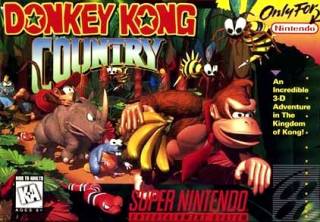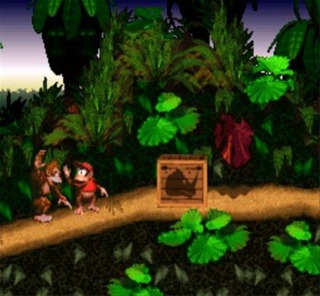Overview
The Donkey Kong Country series began as three platforming games developed by Rare for the Super Nintendo. The games used revolutionary pre-rendered 3D graphics and are some of the greatest selling games on the console. The series then made its first 3D debut on the Nintendo 64 with the release of Donkey Kong 64 and most recently, Donkey Kong Country Returns for the Wii developed by Retro Studios.
Games
Donkey Kong Country
The Heroes: Donkey Kong & Diddy Kong
The Kongs: Cranky Kong, Candy Kong, Funky Kong
The Good Guys: Rambi the Rhino, Expresso the Ostrich, Enguarde the Swordfish, Winky the Frog, Squawks the Parrot
The Bosses: Very Gnawty, Master Necky, Queen B., Really Gnawty, Dumb Drum, Master Necky Snr.
The Final Boss: King K. Rool
 Donkey Kong Country
Donkey Kong CountryThe first game in the series, Donkey Kong Country, was released in 1994 and followed the story of Donkey Kong and his "little buddy" Diddy Kong on quest to find their stolen banana hoard and stop the evil King K. Rool. The gameplay was unique and separated itself from other platformers at the time by allowing players to play as either Kong, using the select button to switch between them at any time. If one character is hit by an enemy, a life is not necessarily lost. One Kong can still finish the level by himself, or can find a DK Barrel to rescue the other. Falling through a pitfall in the level will still cause a life to be lost regardless of whether one or both Kongs are alive at the time. This gameplay offers an element of strategy, using the bigger Donkey Kong to fight stronger enemies or the acrobatic Diddy Kong to make difficult jumps more easily.
 Donkey and Diddy Kong tag each other near a Rambi the Rhino crate.
Donkey and Diddy Kong tag each other near a Rambi the Rhino crate.Donkey Kong Country also featured hidden "bonus room barrels" in which a mini game could be played for bananas (much like Coins in Super Mario World) and extra life balloons. Reaching 100 bananas also grants an extra life, as does finding the four hidden K-O-N-G letters hidden throughout the levels. Animal buddies found in wooden crates will aid the Kongs as well. Rambi the Rhino, Winky the Frog and more offer special abilities but are rarely necessary to complete a level if the player does not find them. Non playable Kongs like Funky Kong and Candy Kong offer services on the overworld screen to travel between the six different main areas and save game progress. Cranky Kong, also unplayable, can be visited in his cabin and will offer hints to finishing certain levels. True to his name, these hints are often given with a bad attitude. At the end of each main area, a boss must be defeated to progress to the next area.
Donkey Kong Country's soundtrack was composed by Robin Beanland, Eveline Fischer and Dave Wise. Tracks such as Aquatic Ambiance and DK Island Swing helped make the soundtrack extremely popular among players, so popular that an album titled DK Jamz was released in 1995.
Donkey Kong Country 2
The Heroes: Diddy Kong & Dixie Kong
The Kongs: Cranky Kong, Wrinkly Kong, Funky Kong, Swanky Kong, Candy Kong (GBA version)
The Good Guys: Rambi the Rhino, Enguarde the Swordfish, Squawks the Parrot, Rattly the Rattlesnake, Squitter the Spider, Clapper, Glimmer, Flapper
The Bosses: Krow, Kleever, Kudgel, King Zing, Kreepy Krow
The Final Boss: Kaptain K. Rool
 Pirate Fever
Pirate FeverAlso released in 1995 was a sequel to Donkey Kong Country, Donkey Kong Country 2: Diddy's Kong Quest. Many people refer to the game as "Diddy Kong's Quest" missing the pun on the word "conquest" in the game's actual title. Donkey Kong has been captured by K. Rool, this time using the name Kaptain K. Rool, and it is up to Diddy Kong and newcomer Dixie Kong to rescue him. The effect that this story had on the gameplay was slightly controversial at the time, as some players were disappointed that Donkey Kong is not playable at any point in the game. Despite this seemingly huge change, Diddy's Kong Quest retained most gameplay elements from the original while introducing many more.
The system of switching between Kongs at any point is still prevalent. Diddy Kong plays much like he did previously, and Dixie Kong's unique ability to slow her descent by spinning her pony tail continues the element of strategy. Animal buddies return, some from Donkey Kong Country and others being original to Diddy's Kong Quest. A new ability to actually transform into some of these animals rather than simply ride on top of them was featured in a few levels, and new non playable Kongs were introduced to the overworld screens such as stylish trivia show host Swanky Kong.
 Diddy carrying Dixie near a bonus room barrel.
Diddy carrying Dixie near a bonus room barrel.An extreme amount of hidden secrets, tokens, and bonus rooms can be found in the game. Although highly praised by both critics and players as a whole, a criticism of Diddy's Kong Quest was that it contained too many collectibles. Tokens were used in exchange for services, which included traveling to and from the various main areas and even saving game progress. Purely optional to the completion of the game, a "Lost World" was introduced and arguably contained some of the most difficult levels in the history of the series.
A considerably darker overall theme is featured in Diddy's Kong Quest. The game takes place on an island belonging to K. Rool, called Crocodile Isle. Sinking pirate ships, damp swamplands, haunted forests and crumbling castles are just a few of the game's atmospheric locations. These locations are accompanied by an equally mysterious soundtrack again composed by Dave Wise, some of the most notable tracks being Stickerbrush Symphony and Bayou Boogie.
Donkey Kong Country 3
The Heroes: Dixie Kong & Kiddy Kong
The Kongs: Cranky Kong, Wrinkly Kong, Funky Kong, Swanky Kong
The Brother Bears: Bazaar, Barnacle, Brash, Blunder, Blue, Bazooka, Bramble, Blizzard, Benny & Björn, Barter, Baffle, Boomer, Bachelor
The Good Guys: Ellie the Elephant, Enguarde the Swordfish, Squawks the Parrot, Squitter the Spider, Parry, Nibbla
The Bosses: Belcha, Arich, Squirt, Bleak, Barbos, KAOS
The Final Boss: Baron K. Roolenstein
 The last DKC game for the SNES
The last DKC game for the SNESDonkey Kong Country 3: Dixie Kong's Double Trouble, the third and final installment of the SNES trilogy, was released in 1996. The game continues the theme of promoting a sidekick character from the previous title to become the star of the next title. Donkey and Diddy Kong are missing after going on a vacation, so Dixie Kong and cousin Kiddy Kong are tasked with finding their location. Kiddy Kong was not as well received by players as a newcomer in comparison to Dixie in Diddy's Kong Quest, and Double Trouble's return to a relatively generic theme and style was criticized. A simple inventory system was brought into the series, along with "The Brothers Bear" who will offer services to Dixie and Kiddy.
Again the gameplay is similar to that of its predecessors. The player must complete various levels, finding bananas and secrets along the way, and defeat a boss at the end of each main area to advance to the next one. The game's overworld, the Northern Kremisphere, was more interactive than in previous installments, featuring different vehicles to explore the land and "banana bird" caves that could be found in usually difficult-to-reach locations. The soundtrack was mostly composed by Eveline Fischer, with Dave Wise assisting. A notable piece of trivia is the cameo of a Nintendo 64 in Wrinkly Kong's Save Cave. A song from Super Mario 64 can be heard in the background as well.
Donkey Kong 64
 All in 3D
All in 3DReleased in 1999, Donkey Kong 64 marked the first time the series went 3D and to a new console. It follows up to the Donkey Kong Country trilogy on the SNES. The plot involves Donkey Kong and his simian relatives to once again win back their banana hoards from the evil King K. Rool. Donkey Kong 64 was the first game to require the Expansion Pak.
It is regarded as one of the biggest and longest single player videogames ever created, due to it's very large amount of collectibles and missions for the player to complete. The game was well received by fans and critics alike and went on to become a Nintendo 64 Player's Choice title. The only criticism was the poor multiplayer mode and hard difficulty of some parts.
Donkey Kong Country Returns
 Wii are back!
Wii are back!Donkey Kong Country Returns is the long awaited sequel made by Retro Studios, the same company that brought us the Metroid Prime Trilogy. It is considered to be a follow up in the series as it uses the traditional side-scrolling elements of the previous games. It is also the first Donkey Kong Country game not developed by Rare.
The game utilizes many of the gameplay elements found on the SNES games such as the mine cart levels, the K-O-N-G letters, the barrels, swinging from vine to vine and the bonus stages. In single player, players can only play as Donkey Kong, although Donkey Kong can use Diddy's jetpack to extend his jumps. Multiplayer mode enables a second player to simultaneously control Diddy Kong. The game has two control schemes; the standard Wii Remote and Nunchuk or the Wii Remote held sideways.
 The title screen to Donkey Kong Country Returns.
The title screen to Donkey Kong Country Returns.Cranky Kong, Rambi the Rhino and Squawks The Parrot are the only cast members that made it from the previous games. King K. Rool and the Kremlings are absent and were replaced by the evil Tikis known as the Tiki Tak Tribe. They have the power to hypnotize living beings and use them as slaves. They have somehow stolen Donkey Kong's banana hoard and it's up to Donkey and Diddy to stop their evil plans.
Other Versions
All of the games in the series have been ported/remade for handheld platforms. These versions are generally disliked by players as the musical quality found in the original Super Nintendo versions is limited by the hardware and many secrets are left out of the game completely. The entire series is also available for the Nintendo Wii's Virtual Console.
TV Series
 Monkeys on TV
Monkeys on TVIn 1998, French/Canadian companies France 2 and Nelvana made a Donkey Kong Country television series. It was one of the earliest TV series to be computer-animated. The show portrays Donkey Kong as the main protagonist who lives in an island called the Kongo Bongo. His mission is to protect a magical coconut called the Crystal Coconut from the evil clutches of King K. Rool and Kaptain Scurvy.
The series ran for forty episodes in two seasons and each episode features two songs performed by cast members. A lot of the show's contents were inspired from Donkey Kong Country and Donkey Kong Country 2: Diddy's Kong Quest, but with some changes. Characters like Diddy Kong, Cranky Kong, Candy Kong, and Funky Kong were present in the show.
Log in to comment